Greenwood, Smith Miller Farm,
"Winters' Evening"
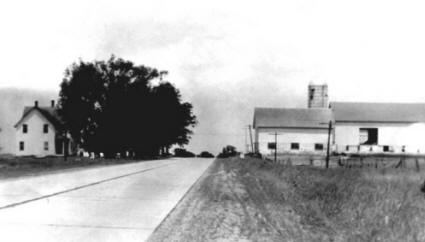
The John Charles Miller Family Farm
Located a mile north of Greenwood, WI
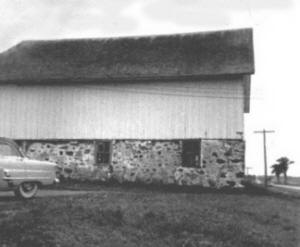
Looking south (toward Greenwood) at the smaller barn.
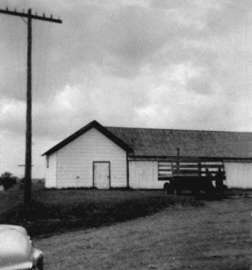
The left side of this storage building was the granary.
The farm implements were stored in the garages on the right side.
The John Charles Miller Farm
A Letter out of the past, From Smitty Miller
It is noted in the current Gleaner that the farm where I was born is up for sale
in three days now, lock, stock and barrel, just like we did to the same place in
1899. Only the price will surely be somewhat enhanced and the volume of
equipment vastly greater.
In reading the list of machinery, I began to wonder just how we ever got the
work done.... Everything then was of the armstrong variety. No electricity, no
power machinery but plenty of horses to pull things.
Our haying machinery consisted of a horse drawn mower, a springtooth
rake.....would rake into windrows and then either shock or next day spread out
with the old pitch fork. Just ordinary wagons with hay racks--no rubber tires
either. We were fortunate in haying to have hay forks to take the hay into the
barns. When grain harvesting came the grains close to the edges we had to cut
with old cradles. I have swung one of those things for days and then had to bind
by hand--not twine either.
Self binders those days were rather expensive luxuries and were usually hired.
Bundles shocked and then either put into stacks or direct to the thresher and
all this in place of the combines that run with but one man.
One single plow and a two section smoothing harrow was all that had to prepare
the soil for crops. And the fertilizer was spread by the old pitch fork and what
a fine rig those were to develop blisters.
In the place of a gas tank we had a large hay mow that held a whale of a lot of
timothy hay-fuel for the dobbins.....Well, it was hard work and now seems pretty
crude but we sure felt well all the time. When we earned some money or sold
something...it bought more per buck and we didn t go through it so fast either
for we knew how we got it. Even with all the lack of present pleasure
facilities, we had a heap of fun that in my reasoning is greater than these kids
have now.
To this day I can hear the sonorous voice at 3:00 a.m. of one John Charles
Miller, my Dad, ring up that stairway, "Smith, get up!"
Editors note--The farm Mr. Miller speaks of is the George Speich farm just north
of
Greenwood on 73, which was recently sold and an auction was held.
SOURCE: Greenwood Gleaner 23 APR 1959 S.H. Miller
COLD WINTER EVENING--LATE 1880'S
Smitty Miller (Son of John Charles) writing from Concrete, WA about his
boyhood home in Greenwood, WI.
The cold weather....prompts me to write about one of those early winter evenings
in the old Wisconsin farm home.
It would be one of those very, very cold evenings and the family of six children
and Father and Mother together with the hired girl and hired man and the yellow
dog and tomcat all grouped around the round oak stove red way up in the stove
pipe. The dog and cat laying there asleep and the dog chasing the white rabbit
around the woods.
We all sat there munching popcorn and listening to Father read the news from our
twice-week Milwaukee Journal that was the sole medium of news we were able to
get in those times. Father would read, now here is a dispatch from Chicago.
Every item of news was a Dispatch-for, I think the news items were so designated
in those days. There was no news wires or other mediums except the Journal and
that but twice a week. Every month we would get the Youth's Companion but no
news was in that periodical. But the world was at peace so we were contented.
With the news having been read and Little Mother sat there with her knitting by
the old oil lamp and listening to the hired girl tell us young folks ghost
stories. And let me say she sure knew some dillies, too. Of course we sat
munching popcorn listening when she finally wound up with the old poem:
Little Orphan Anne came
to our house to stay.
To wash and wipe the dishes
and brush the crumbs away.
The body of this poem is forgotten but I'll never forget the ending:
And when she went upstairs to bed
Two great big black things
were standing by her side
And they whisked her through
the ceiling.
Before she knew what it was
all about.
And the goblins will getchu
ef yu don't watch out.
That one, on top of the ghost stories, was a honey but to make it more
realistic, I suppose, the hired man chimed in with his accordion with about the
weirdest tune one can imagine and it synchronized perfectly with the ghosts. So
we listened to Father saying the evening prayer and prepared for bed.
Now, believe me it took a lot of fortitude for this young chap to go up those
dark stairs but I gritted my teeth and went up....like greased lightning. The
top of the stairs, I thought, would be a good place for those goblins but I made
it past that area safely and dashed down the hall, passed some dark open
doorways and piled into bed abut half undressed and covered up and
listened........ For a minute or so it was real quiet but all of a sudden.....
something jumped on top of me. That was IT for sure ....but it just went
over the side of the bed and curled around and around and before long I heard a
soft purring and then I knew that the tom cat had come gumshoeing up the stairs
and jumped on the bed. So I, too, then, hit dreamland. And in that dream were
all the denizens of the pine forest congregated in a beautiful area by the old
river with a gorgeous moon shining on them in their kingdom of frost.
SOURCE: Puget Sound Mail clipping 27 FEB 1964 S. H. Miller (writing from
Woodinville WA; one of his last stories)
The George Speich Farm
After John Charles Miller relocated his family in Washington state, this
property was purchased by George Speich. We don't know if anyone owned it before
him or if he ever farmed it himself because he owned several farms in Clark
County. But in the Spring of 1953 he gave his son, Jake Speich, a farm he owned
in Braun Settlement which was being farmed for him by Ewald Schwarze. Ewald and
his family moved onto this farm and ran it for George who was retired and living
in Greenwood, WI.
Ewald's son, Stan, had not quite completed second grade in the Braun Settlement
School and was transferred to the grade school in town. Over 50 years had passed
since Smitty Miller had lived there. Stan also recalled his boyhood days on this
farm and he wrote:
My first memories of the farm were not so pleasant. We had moved from a house
with running water and indoor plumbing. Having to go outside to pump water and
go to the bathroom was not fun, especially at night if you drank anything before
going to bed. Baths became a luxury. Warming up water on the stove and pouring
it into a washtub was not something done every day. Once a week was the most we
ever took a bath. The poor kids at school that had to smell me. No one ever
complained, so it must not have been too bad. I think the smell of a farm was
pretty familiar to most of the community.
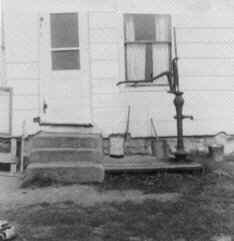
Our Only Source of Water was this hand pump,
just outside the kitchen door.
I don't know what on earth possessed to do it, but one particularly harsh, cold
day, I made the mistake so many others made before me and learned I the hard
way
.don't ever try to lick ice off a pump handle! It can be a mighty
painful experience.
It wasn't until the first winter that we got the shock of how cold a house with
no furnace can be. We had a small oil burner which heated the dining room and a
wood cook stove in the kitchen. That was the only heat we had. For those
howling, Wisconsin winter nights, my folks put a bed in the downstairs hallway
for the kids to sleep because the upstairs wasn't heated.
We had several dogs while living on various farms in Warner Township. However,
because this farm had the house on one side of the highway and the barn on the
other, ever single dog we had was eventually run over by a passing car. My
favorite dog was name Bingo. We had him the longest and he was the
friendliest and dedicated of the lot. It was a mighty sad day when I found him
dead beside the road.
I was able to start driving tractor within a year or so after moving onto this
farm, and that was a lot of fun for me. I drove for baling hay and also for
preparing fields in the spring. To this day, I enjoy driving my garden tractor
to mow our lawn.
One of the most enjoyable parts of living on this farm was at threshing time.
The area farmers jointly owned a threshing machine, so the farmers would work
together to thresh the oats in the late summer. We would move from one farm to
the next and work long hours to get the job done. Once again, my job was to
drive a tractor. I used it to pull one of the wagons heaped with oat bundles to
be hauled to the threshing machine. I would drive from one set of shocks to the
next, while the farmers loaded the bundles onto the wagon. When one was full, I
moved to another tractor and wagon, while a farmer took the full load up to the
threshing machine. The highlight of this community effort was the scrumptious
dinners with an abundance of homemade specialties and fresh baked pies and
bread. This was quite an undertaking for the women who prepared them because 15
to 20 hardworking and few boys like myself could really chow down the food!
We did not have our own corn chopper, so Frank Trampush was always hired to come
in and chop corn for silo filling. That was done in the fall during school, so I
only helped on weekends. We had two silos, one about 50 feet tall and the other
about 40 feet. We filled both of them with chopped corn every fall. My mom
shivered when I climbed them.
One of the more significant events that happened while we were living there, was
the birth of a two-headed calf. It died shortly after birth, but George Speich
had it stuffed. It was on display at the Speich Implement Shop for years
afterward.
The west edge of the farm bordered the Black River. In the summer I would often
stroll down to the banks and search for rocks or fish. It was always so peaceful
and quiet there. The property also bordered the Greenwood Park on the south
side, so I would meet friends and go swimming by the dam.
Sometime during the years we lived on this farm, a new foundation was built for
the main barn and it was moved from the old foundation to the new, which turned
it 90 degrees. We had an automated barn cleaner in the new barn. What a treat!
We milked about 50 cows most of the time, but in the summer when they were
calving, we only milked around 30. We were always up at 4:30 a.m. to do the
milking. We usually finished by 7:00 a.m., and then I got ready for school. We
milked again at 5:00 p.m. and finished by 7:15.
We moved into Greenwood in the Spring of 1959 when George Speich sold the farm
to Ronald Kitzhaber. The day after the cows were sold, I got to sleep in and
that is one of my most enjoyable days on the farm. We did not get up until 6:30
a.m. that morning. The next day we moved to a house right next door to my
grandparents and I happily became "one of the town kids."
SOURCE: Schwarze Family Album.
TWO HEADED CALF IS BORN ON THE GEORGE SPEICH FARM
On Monday, September 17, 1956, a two-headed calf was born that morning to a
first calf Holstein heifer, on the George Speich farm, 2 miles north of
Greenwood. The calf died in the afternoon. According to Dr. Cook, local
veterinarian, this type of birth is very rare.
The animal was born with two distinct heads, joined to the body at the
shoulders. Ewald Schwarze, who is employed at the farm, said both heads were
identically marked and functioned separately. First one head would blatt and
then the other, Ewald said. The animal was unable to stand on its legs and was
fed from a bottle. Not knowing whether the body contained two digestive systems,
both heads were fed and they both ate.
Although the carcass was not dissected, it is believed to have contained two
sets of lungs and it appeared that a spinal column extended from each neck to
the hips.
When the animal died, Ewald said one side stopped functioning and then the
other. The carcass was taken to Medford for mounting.
SOURCE: Greenwood Gleaner.
| LIST OF OWNERS Through the
years, this property passed through many hands and why the various
transactions took place was not always clear. It was not obvious how
some people had come to own the land. The following list of
transfers was taken from the Clark County Courthouse.
1863--Clark County sold it to C. W. Carpenter
1871--Transferred from C. C. Merrick to C. W. Carpenter
1873--C. C. Washburn to C. W. Carpenter
1873--George Haner to C. W. Carpenter
1873--B. F. French to C. W. Carpenter
1876--Chandler Brown to Thomas Miller
1882--Thomas & Oliva Miller & wives to Charles & Betsy Miller
1901--John Miller to Peter Hansen
1901--Herbert Sweet to Peter Hansen
1902--John Miller and E. Sweet to Peter Hansen
1902--Peter Hansen to William Worth
1903--Peter Hansen to Heirs
1904--Foreclosure--back to Gard Miller
1905--Hattie Miller to Abraham Speich
For many years it was also owned by George Speich and is now the
property of Bernie Kitzhaber. |
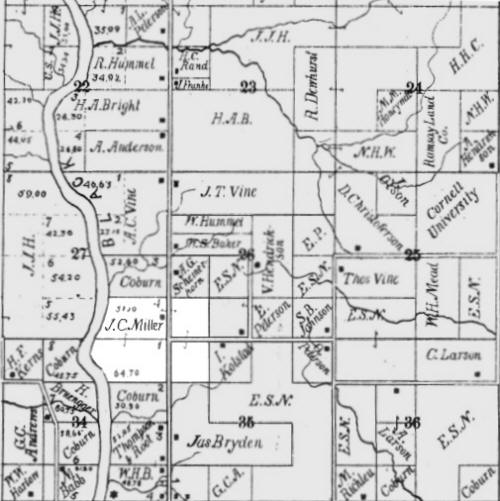 |





